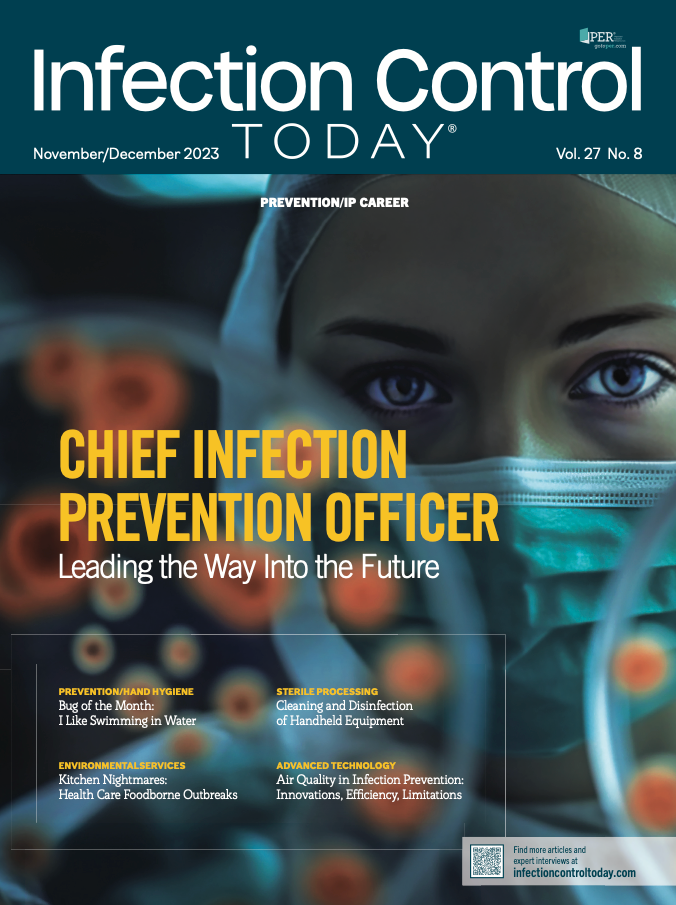"Rounds in the kitchen should occur routinely with kitchen staff, facilities, regulatory leads, and other stakeholders. When rounding, observe the food preparation practices, especially for ready-to-eat items such as sandwiches, salads, and raw produce. Food safety classes should be part of the competence and training for kitchen staff."
Kitchen Nightmares: Health Care Foodborne Outbreaks
Learn how infection preventionists (IPs) are key to ensuring food safety in healthcare facilities, addressing foodborne illness risks, and fostering a culture of prevention.
Health care professional kitchen
(Adobe Stock 630762548 by vadymstock)

When infection preventionists (IPs) think of health care–associated infections and outbreaks, often the first consideration that comes to mind is not foodborne illnesses. However, food safety is part of the duties of a facility IP, and there are many key details to consider when evaluating your local health care facility kitchen.
Outbreaks associated with foodborne pathogens do occur in health care facilities. Studies of these outbreaks have been published, but one challenge is determining whether the exposure occurred in the facility or before admission. The incubation period can vary from hours to weeks, depending on the pathogen identified. For example, listeriosis has an incubation of up to 2 to 3 weeks, whereas salmonellosis has an incubation period of 12 to 72 hours.1
A study review in 2014 found 30 published reports of possible health care–associated listeriosis outbreaks.2 Of the total cases, a median of 25% were determined to be directly related to food consumption while in a health care facility. Additionally, the median case fatality rate was 25%. Listeriosis is a particular concern because of the high level of morbidity and mortality associated with at-risk populations. Immunosuppressed, pregnant, and older individuals are all at the highest risk for severe outcomes, and all are often in a health care environment and at their most vulnerable. Common food sources identified through a review of food history and isolation of positive cultures included sandwiches (provided by outside caterers and made in-house), butter, celery, soft cheeses, and tuna salad.2 All these food sources are intended for consumption without further preparation.
A second study from 2019 described 2 foodborne outbreaks of listeriosis in patients receiving treatment at a cancer center.3 Similar to prior outbreaks, premade sandwiches were identified as the source of the pathogen. Ultimately, the deli meat slicer was presumed to be the site of cross-contamination, as the manufacturer’s recommended cleaning and sanitizing instructions were not followed correctly.3
Listeria is not the only concern for foodborne outbreaks. An article in 2021 described an international review of more than 80 healthcare foodborne outbreaks that identified pathogens such as salmonella, norovirus, Clostridium perfringens, group A streptococci, and Escherichia coli.4 The settings included acute care hospitals, nursing homes, rehabilitation centers, and long-term care centers. Similar to the prior studies, common food sources included sandwiches, fresh or frozen fruits and vegetables, and meat or egg products. Another novel aspect of this review was to look at the antibiotic resistance identified in the pathogens, which can further increase the potential for harm depending on host factors.4
Patients, residents, and staff are at risk for foodborne illness due to food. As an IP, I have been involved in an outbreak investigation after a local staff education event hosted in our facility and catered by an outside company. On the day following the conference, numerous clinical staff called off due to gastrointestinal illness, all of whom had attended the event. This triggered an outbreak investigation in collaboration with the local health department. Although the source was not determined, some trends were identified in the foods eaten. The catering company was also included in the investigation, and some issues were identified with the storage and preparation process at the catering facility. Additionally, as part of their planning process, the conference coordinators reviewed all outside caterers to ensure they were registered with the local health department and had all the required permits in place.
Considerations for prevention would include collaboration with kitchen, dietary, and clinical teams to identify high-risk foods that should not be served to immunocompromised or at-risk patient groups. Additionally, labeling premade food items to identify those foods in a cafeteria setting is recommended for high-risk patient groups, such as sandwiches with deli meat or soft cheese products. Review your facility’s cleaning and disinfection processes for food preparation areas and machinery. As with patient care devices, the food production machinery can be complicated and challenging to disassemble appropriately to meet the manufacturer’s requirements.
Rounds in the kitchen should occur routinely with kitchen staff, facilities, regulatory leads, and other stakeholders. When rounding, observe the food preparation practices, especially for ready-to-eat items such as sandwiches, salads, and raw produce. Food safety classes should be part of the competence and training for kitchen staff. Carriers among food preparation staff have been identified in outbreak investigations, in which the pathogens were spread by not following appropriate hand hygiene practices.
Check temperature logs where foods are stored and ensure the appropriate foods are stored together. Does your facility have a process to date all food items with an expiration or preparation date? If a bulk package is opened, is it labeled with the new expiration date based on the opened date? All these and more can be captured with a robust rounding tool or checklist that can be used for routine rounds with your dietary and kitchen staff colleagues. Similarly, when rounding on patient care units, inspect galleys and kitchens. Do you have a process to check food expiration dates in the galleys? Are all foods labeled correctly? Also, is there a process to handle patients bringing food from home or an outside food establishment?
The kitchen environment must also be maintained in a clean and sanitary manner. Outbreaks have been associated with contamination of produce from splash-back from kitchen sinks.5 Clean and dirty spaces must be clearly identified, as well as hand washing sinks apart from sinks used in food preparation. All chemical disinfectants must be registered with the Environmental Protection Agency and used according to manufacturers’ instructions. If chemicals need to be diluted prior to use, ensure staff can speak to that process and understand how to check the concentration levels. If solutions are being used in a bucket system, have a process in place to determine when it’s time to change out the buckets and fill them with fresh chemicals. Some products on the market have an indication system integrated into the buckets to make it clear to everyone when it’s time to change the chemical.
Be aware of the types of equipment used in your kitchen environments. Grill hoods require routine cleaning and professional maintenance. Dishwashers have specific temperature and time requirements for cycles. Additionally, ensure that if you have any other dishwashers in patient care areas, such as in a long-term care setting or rehabilitation center, those dishwashers are expected to function as commercial kitchen dishwashers.
Have a process for food recalls and traceback capabilities for the food products brought into your facility. How are you tracking and logging the food products being delivered? If there is a recall, do you have a process to identify and remove any affected products? Develop communication with vendors and contractors to ensure any recalls are shared appropriately and promptly.
If you identify a possible foodborne outbreak in the health care facility, the first step should be to notify your local health department. They can aid with conducting the investigation and the next steps and coordinate with sanitation inspectors for the kitchen. Additionally, try to isolate the potential food sources under question. Identify your line list of contacts to interview. All the steps associated with outbreak investigation should be taken to help identify the possible source of food or food preparation practices that can pose a risk.
A robust infection prevention program must consider the facility’s food safety culture. Build relationships with your kitchen leadership and staff, engage, and regularly round in the food preparation areas. Ask questions and educate yourself about the expected regulatory requirements and safe food handling practices. All these efforts ensure there will be no kitchen nightmares in your facility.
References
- Heymann DL. Control of Communicable Diseases Manual. 20th Edition. American Public Health Association; 2015.
- Silk B, McCoy MH, Iwamoto M, Griffin PM. Foodborne Listeriosis acquired in hospitals. Clin Infect Dis. 2014;59(4);532-540.
- Hobbs JL, Lee C, Thompson B, et al. Two Listeria moncytogenes outbreaks in a cancer centre: onsite food premises and their potential health risk to patients. BMC Public Health. 2023(23):1443.
- Boone I, Rosner B, Lachmann R, et al. Healthcare associated foodborne outbreaks in high-income countries: a literature review and surveillance study, 16 ODEC countries, 2001 to 2019. European Surveillance. 2021;26(41).
- Letter to the Editor: role of the kitchen environment. Infection Prevention in Practice. 2021.
